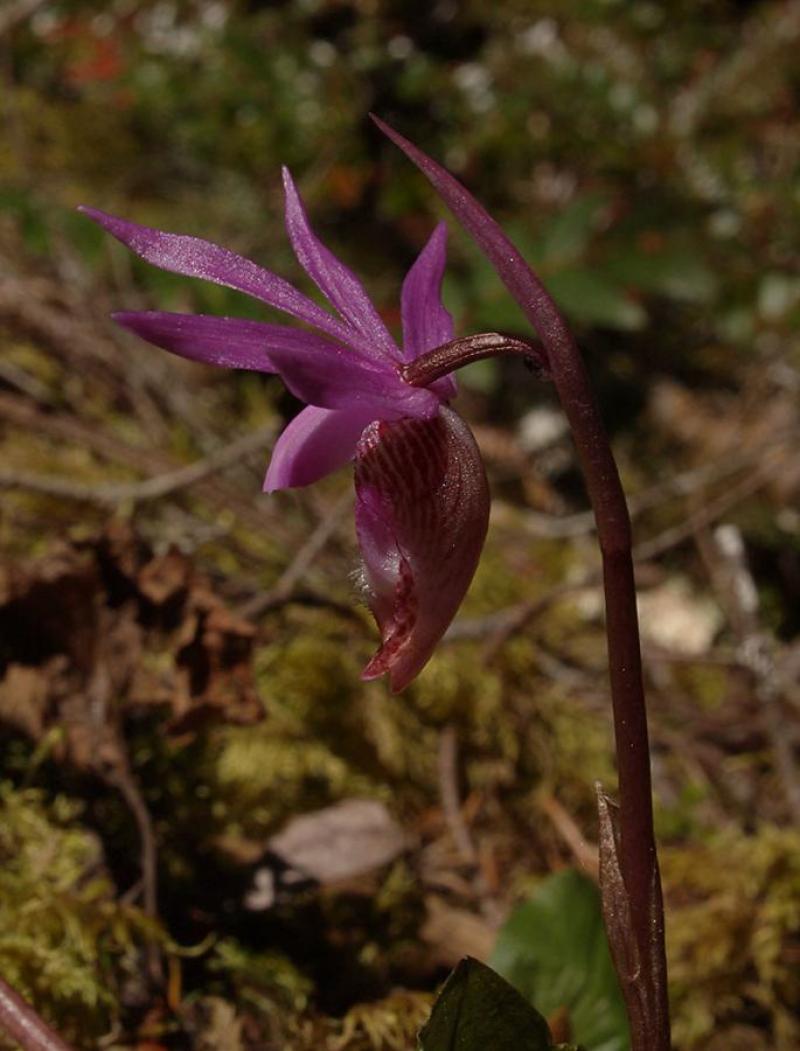Calypso bulbosa
Also known as: Fairy Slipper or Orchidium boreale Orchidium americanum Orchidium arcticum Calypso bulbosa h.v. americana h.f. rosea Calypso bulbosa h.v. americana h.f. biflora Calypso bulbosa h.v. occidentalis h.f. nivea Calypso bulbosa h.v. occidentalis h.f. bifolia Calypso borealis Calypso bulbosa h.v. californica Cypripedium bulbosum Calypso bulbosa f. occidentalis Calypso occidentalis Calypso americana Calypso bulbosa h.v. americana h.f. albiflora Cytherea borealis Calypsodium boreale Norna borealis var. asiatica Cymbidium boreale Norna borealis var. americana Calypso bulbosa f. albiflora Cytherea bulbosa var. occidentalis Calypso speciosa Cytherea speciosa Calypso bulbosa f. rosea Norna borealis var. europaea Calypso bulbosa f. candida Cytherea occidentalis Calypso bulbosa ssp. occidentalis Calypso bulbosa f. nivea Calypso bulbosa f. americana Calypso bulbosa var. speciosa Calypso bulbosa ssp. americana Calypso bulbosa nothovar. kostiukiae Calypso bulbosa f. biflora Calypso bulbosa var. bulbosa Calypso bulbosa var. occidentalis Calypso bulbosa var. americana Limodorum boreale Norna borealis Pink Slipper Redwood Orchid (California) False Lady's-slipper Orchid Chinese Lady's-slipper Hider-of-the-north in the subfamily: Epidendroideae
Native to: Alaska - United States Arizona - United States Canada Kentucky - United States New Jersey - United States New Mexico - United States Pennsylvania - United States
General Information
Fairy Slipper is a dwarf cold growing terrestrial orchid belonging to the sub family Epidendroideae native to United States and Canada.
Plant Description
Grows to 20cm. Each new growth has a single oblong shaped leaf that grows to 1-6cm long. Pseudobulbs grow to 1-2cm
Substrate(s)
- Sand
Care Notes
These orchids grow on the forest floor so are used to rich soil containing plenty of organic matter that is always moist (but not always wet), and prefer constant conditions in terms of humidity, temperature and water supply. They may not be as forgiving as epiphytes in regards to sudden changes in growing conditions so it is wise to ease them into new conditions over a the space of a few days, and repot as infrequently as possible.
Keep an eye on the plants condition regularly as they can decline suddenly if the conditions are not just right. It is more important to keep water supply constant rather than frequent - overwatering often causes rot which can quickly set in, especially in warmer conditions.
These can be grown in shady, moist areas in the garden, supplied they have protection from abrupt changes caused by the elements, e.g. dry winds, frost etc. Being grown around companion plants such as ferns and bromeliads will help build and retain the humidity they require throughout the year.
Climate
These orchids grow in cool climates, at low altitudes, in cool plains, forests or coastal scrub.
They are forgiving of humidity variances as long as temperatures are kept on the cool side. They can do well outdoors in the garden in cool and temperate areas, though it is important that they are protected from warm dry winds. They can enjoy morning sun especially in winter but will need protection from the hot sun in the afternoon and during summer. With some acclimatisation they may be able to receive more sun.
Grows at low elevations. Rainfall ranges from 13mm to 61mm per day, heaviest in July and lightest in May. Humidity ranges from 61% to 76%, highest in September and lowest in May. Temperature ranges from -14C to 18C, highest in July (10C to 18C) and lowest in December (-14C to -7C).
Watering
These orchids prefer a constant supply of moisture, with a slight drying out between waterings. Saucers can be placed under pots to retain moisture during hot weather, however the saucers should be removed or let to dry every 1-2 weeks to prevent rot. Keep an eye on the plant especially in hot weather and look for cues of under/overwatering and adjust accordingly.
Fertiliser
Apply liquid based fertiliser per recommended directions. They can benefit from a high phosphate fertiliser leading up to flowering season, followed by a high nitrogen fertiliser when new growth appears, and a balanced fertiliser in other times. These orchids can also tolerate slow release fertiliser applied 1-2 pellets per cup (250ml) of media.
Use balanced fertiliser during Spring and Summer. Apply fertiliser regularly at half strength year round. Use a high Nitrogen fertiliser during Spring and Summer. Use a high Phosphorous fertiliser during Summer.Potting
These plants can be sensitive to repotting though should not require repotting regularly. Repotting should be done when the mix has broken down to the point that it doesn't absorb water or holds onto water for far too long, usually the plant shows a decline in growth as well.
The mix should be free draining, with a blend of 30% inorganic ingredients such as coarse sand, gravel or perlite, mixed in with about 70% organic ingredients such as peat, leaf litter or decomposed bark. Avoid commercial potting mixes as they can vary wildly and may contain "wetting agents" that can hold onto water for loo long, causing rotting and stunted growth.





















